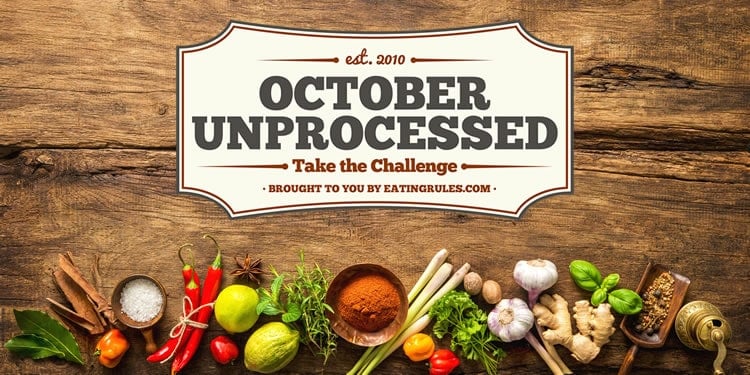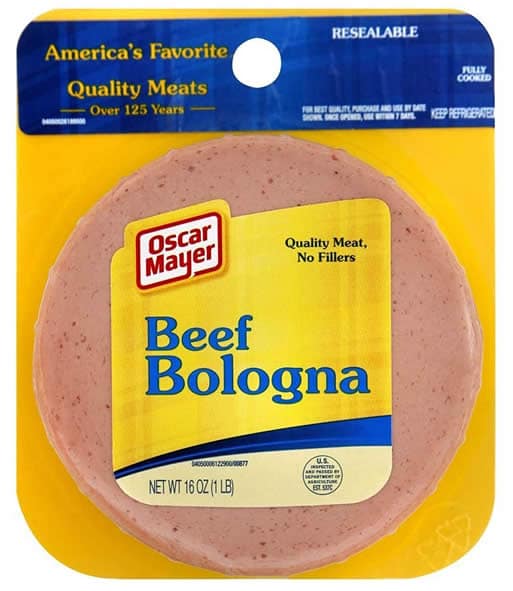Unprocessed FAQ: The Kitchen Test
Sep 20, 2019

We’re just a couple of weeks away from the start of the October Unprocessed challenge! If you haven’t taken the pledge yet, please check it out and then come back here and keep reading.
I get asked a lot of questions about how to define “unprocessed,” and how my definition applies to specific ingredients and foods. I’ve previously published a series of Frequently Asked Questions posts – I’ll be re-publishing them over the next few weeks to bring them to the top of the pile and help everyone prepare for this year’s challenge.
The Kitchen Test
Because there are always so many questions about how to apply my “Kitchen Test,” let’s take a quick look at it:
Unprocessed food is any food that could be made by a person with reasonable skill in a home kitchen with whole-food ingredients.
The Kitchen Test is how I define “unprocessed.” It works well for me, and many people find it works well for them, too. But it may not fit with your definition of “unprocessed,” and that’s totally okay. In fact, I encourage disagreement and discussion, since that’s the best way for us to learn together.
I also recognize that the Kitchen Test isn’t perfect. My goal here isn’t perfection – it’s more to spark a dialogue, increasing awareness about how our food is made, what we’re putting into our bodies, and how we relate to our food.
Whole-Food Ingredients
The Kitchen Test doesn’t mean that you have to make the food. Nor does it mean that you necessarily need to be able to make the food (you don’t have to be Julia Child!). It just requires that the food could be made in a home kitchen by someone who knows what they’re doing, using whole-food ingredients.
So we also have to define “Whole-Food Ingredients.”
I start by trying to figure out if I could grow/create/produce that ingredient at home, at least in theory. If the answer is yes, then it’s good to go. But if it’s made through an industrial or complicated chemical process that couldn’t be done in a kitchen (however you define “kitchen”), or could only be made “in a laboratory,” then it’s out.
The big idea, ultimately, is to consider each ingredient in your food: How it’s produced, where it comes from, and whether its benefits outweigh its detriments.
We’ll talk more about specific ingredients over the next few weeks, but in the meantime, just remember that anything you could make at home, from ingredients that you could produce at home, will pass the test.
Packaged Foods
While cooking from scratch is obviously the ideal choice, it’s not always feasible or practical. Most people (myself included!) are not going to prepare everything from scratch, especially if you’ve got a job, school, kids, pets, or are traveling…
So what to do when you buy packaged food? The answer is simply to consider every ingredient separately.
My favorite example is comparing two “energy bars.” Here are the ingredients for the PowerBar Protein Plus Chocolate Peanut Butter:
trisource protein blend (soy protein isolate, calcium caseinate, whey protein isolate), maltitol syrup, chocolate flavored coating (sugar, fractionated palm kernel oil, cocoa, whey, nonfat milk, soy lecithin, natural flavor), oligofructose (from chicory root), fructose, water, cane invert syrup, peanut butter, partially defatted peanut flour, soy crisps (soy protein isolate, rice flour, salt), peanut oil, and less than 2% of: salt, ground almonds, natural flavor, soy lecithin, butter (cream).
I’ve bolded any ingredients that I’m pretty sure you can’t make at home (some of these might be debatable, but I’ll leave that for the next few posts). Compare that to the ingredients of a Cashew Cookie Larabar:
cashews, dates.
I’m absolutely certain that a person with average skills could make something comparable to the Larabar in his or her kitchen. But the PowerBar? Not so much.
(Since I originally wrote this post, General Mills bought Lara and started introducing new varieties — including “natural flavors” in some of them. The “Uber” bars also used brown rice syrup, which is a concentrated sugar that you probably couldn’t make at home. However, they’ve since “retired” the Uber bars, and it looks like most of their products once again pass the Kitchen Test. Since last year, though, they introduced a “Protein” line that includes pea protein, so those wouldn’t pass the test.)
Restaurant Foods
Eating out is probably the hardest part of the challenge. Since you don’t know the ingredients, you just have to do the best you can. Some dishes are more likely to pass the kitchen test. Here are some strategies I use — if you have other suggestions, please share them in the comments:
- Talk to your waiter. It’s totally okay to tell your waiter that you’re eating only unprocessed food, and ask him or her questions about the food they serve. You’re about to put it in your body – you have every right to know what it is. If the waiter doesn’t know, ask to speak with the Chef. Just remember to be friendly and polite.
- Avoid large, chain restaurants. They often have lots of additives, stabilizers, conditioners, and preservatives in their foods (since they’re rarely made fresh). Obviously that’s a generalization, but you’re usually better off at a small, family- or chef-owned restaurant.
- Find a local, “farm to table” restaurant, if you can. More and more like-minded restaurants are popping up all over the country, so seek them out… and let them know about the challenge!
- A Fresh Salad is usually a good choice. It’s the dressing you’ve got to watch out for. A good choice is Olive Oil and Balsamic Vinegar, both of which pass the Kitchen Test.
- Pasta may pass the test — if it’s made with unbleached, unenriched flour (if you can find 100% whole wheat pasta at a restaurant, you’ll be in good shape). Then you just need to ask about the ingredients in the sauce. Olive oil and garlic, anyone?
- Cooked Vegetables usually work well.
- If you eat meat, that’s usually a good choice, depending on how it’s prepared. (Again, watch the sauce.)
- Tofu and tempeh usually pass the kitchen test. (Seitan is a gray area… You could make seitan at home from wheat flour, but at the commercial level it’s usually made with vital wheat gluten).
The Deliberate Exception Clause
I encourage you to consider exceptions, if any, you will make to your definition of unprocessed. The idea is to decide on any exceptions before we start, if possible. It’s not there for you to use your exceptions as a way to cheat in the moment. Instead, it’s about making an informed decision, in advance, about a particular food.
For example, Matty and I have decided that Vital Wheat Gluten is an acceptable ingredient for us, because we’d rather eat whole grain bread (preferably baked ourselves) that is made with some extra gluten, than to eat bread made with refined grains. We carefully considered it in advance, and decided that the “pros” outweighed the “cons.”
It’s also okay to make an exception for something you feel you need to do to make it possible for you to complete the challenge at all. For example, maybe you’re a five-cans-of-soda-a-day person (like I once was), and have decided that for October, you’re going to limit yourself to just one can of soda each day.
Remember that this is fundamentally an awareness exercise, and ultimately, you need to do what’s right for you, and what’s going to work for you.
If you haven't taken the October Unprocessed pledge yet, please do! And then encourage your friends to join in -- it's a lot more fun that way!






















Ready to try this.
Hi!
I’d like to do this challenge, too. But I have a few questions:
Is light mayo from a bottle considered processed already?
What about yogurt from the supermarket such as Bulla?
What about powdered stevia?
I suppose vinegars — balsamic, red/white wine. apple cider — are allowed?
HI! Glad you’re jumping in with us! For mayo and yogurt, you’ll need to read the ingredients — some will pass the test, but man others won’t. If the ingredients are whole foods that you yourself would use to make it in your kitchen, then they’re okay. (I’m not familiar with Bulla, but the larger brands of store-bought yogurts tend to include gums, stabilizers, or natural flavors — none of which you’d use to make yogurt at home). Powdered stevia is highly processed. But, you can make your own stevia extract! (And some of the liquid store-bought ones would be okay then, too). And it’s easier than you might think to make your own yogurt – so you might want to give that a try, too! For the vinegars, I personally think they’re okay. I’d avoid distilled white vinegar, but the ones you named could be made at home and… Read more »
Great! 🙂
Will go over the rules and see what I’d need to do to prepare. Thanks! 🙂 This is awesome!
I’m pretty sure I pass the kitchen test year-round. But I agree, restaurants are tough. I always go for the most creative thing on the menu. I figure KRAFT wouldn’t get near that stuff. GREG
Hi fellow pledgers..
I’m excited for October. Unprocessed and challenging and fun it shall be. In the meantime however, I have a few weeks to stock up on both pantry goods (i.e black beans & rice) and things to make in advance (i.e homemade Lara bars which are really good frozen). I am a full-time student who easily spends an 8 day @ school and I’m interested in lunch/snack/meal ideas you guys have that might help keep me an unprocessed food eating student…
Could we start that– sharing recipes, meal ideas?
what about citric acid found in tomatoes? is it considered natural?
I took the pledge and then checked my purchased food. So far I’ve found only Hershey’s Unsweetened Cocoa Powder, Vital Wheat Gluten, Tofu and spices. I’m letting all of those pass my test. Yes, I could and have made my own tofu and I could grind my own spices – always grind my own nutmeg and either do or have grown many herbs, but ground spices are staying. I’m going to be making my own Low Carb, High Fiber tortillas starting in 3 weeks – I have 2 pkgs to use up. Also I’m using up my last package of Morningstar Veggie Burgers and will make my own probably with black beans. I already make my own seitan – a baked version that is really good which will work in place of commercial veggie burgers. Guess I eat pretty clean already – never really thought about it. My food choices… Read more »
Bellen, perfect timing! This came across my FB feed this morning: http://www.onegreenplanet.org/vegan-recipe/epic-veggie-burgers-to-throw-on-the-grill-now/
This comment really inspired me more than any other.
Okay I’m in. What an excellent idea.
Reading this post I just realized that I joined this challenge two years ago and have been unprocessed ever since. My definition of processed is as much philosophical as anything. If it’s made by a factory process, I call it processed. If it’s out of season locally, I call it processed, unless I myself processed it.. I have five exceptions: coffee, tea, flour, sugar, pasta, and tropical fruit that I could never get locally (principally avocados and bananas). Living in California makes this easy (unless it never rains again). My son lost120 pounds by eating according to this definition, so we’re sticking with it! Thank you for helping us change our lives by thinking about what processing is, and thus defining how we eat and live.
my favourite illustration of the ridiculousness of fast food is the Chick fil a basic sandwich, I stopped counting once I hit 50 ingredients
http://www.chick-fil-a.com/Food/Menu-Detail/ChickfilA-Chicken-Sandwich#?details=ingredients
Lets face it regular MILK is “processed”…so we need to draw the line here….or there will be very little to eat that passes your test. To me the worst kinds of “Processed foods” are things like Chicken nuggets, Mc Rib,hungry man TV dinners and other “Franken foods” mostly made up of cheap ingredients like corn and a soup of chemicals and unhealthy fats and GMO. It is nearly impossible to get away 100% from all processed foods. So you have to read labels..and get smart about what you put in your mouth…you would never put diesel in a gas powered car…but people do similar things with what they eat every day!
Martin, everyone needs to decide what’s acceptable for them (for #unprocessed as well as beyond). Grocery store milk might be acceptable for some folks, while others might want to stick with raw milk from the coop.
You are absolutely right about needing to read labels and learn more about what’s in our foods and beverages. It’s frightening!